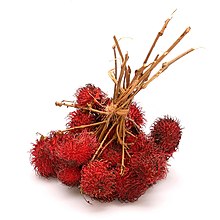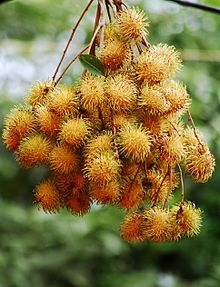| Rambutan | |
|---|---|
 | |
| Unpeeled and peeled rambutan | |
 | |
| Rambutan fruits in bunches | |
| Conservation status | |
| Scientific classification | |
| Kingdom: | Plantae |
| (unranked): | Angiosperms |
| (unranked): | Eudicots |
| (unranked): | Rosids |
| Order: | Sapindales |
| Family: | Sapindaceae |
| Genus: | Nephelium |
| Species: | N. lappaceum |
| Binomial name | |
| Nephelium lappaceum L.[2] | |
There is a second species regularly for sale at Costa Rican markets which is known as "wild" rambutan. It is a little smaller than the usual red variety and is colored yellow. The outer skin is peeled exposing the fleshy fruit inside which is then eaten. It is sweet, sour and slightly grape like and gummy to the taste. In Costa Rican Spanish it is known as mamón chino (translated "Chinese sucker") due to the likeness of the edible part with Melicoccus bijugatus and its Asian origin.
Rambutan are non-climacteric fruit - that is, they refuse to ripen unless on the tree.
Contents[hide] |
[edit] Description
It is an evergreen tree growing to a height of 12–20 m.[4] The leaves are alternate, 10–30 cm long, pinnate, with 3-11 leaflets, each leaflet 5–15 cm wide and 3-10 cm broad, with an entire margin. The flowers are small, 2.5–5 mm, apetalous, discoidal, and borne in erect terminal panicles 15–30 cm wide.[4]Rambutan trees are either male (producing only staminate flowers and, hence, produce no fruit), female (producing flowers that are only functionally female), or hermaphroditic (producing flowers that are female with a small percentage of male flowers).
The fruit is a round to oval drupe 3–6 cm (rarely to 8 cm) tall and 3-4 cm broad, borne in a loose pendant cluster of 10-20 together. The leathery skin is reddish (rarely orange or yellow), and covered with fleshy pliable spines, hence the name rambutan, derived from the Malay word rambut which means hairs. The fruit flesh is translucent, whitish or very pale pink, with a sweet, mildly acidic flavor.[4]
The single seed is glossy brown, 1–1.3 cm, with a white basal scar. The seed is soft and crunchy. They are mildly poisonous when raw, but may be cooked and eaten.
[edit] Production
It is a popular garden fruit tree and propagated commercially in small orchards. It is one of the best known fruits of Southeast Asia and is also widely cultivated elsewhere in the tropics including Africa, the Caribbean islands, Costa Rica, India, Indonesia, the Philippines, and Sri Lanka. Thailand is the largest producer from Surat Thani Province Thailand. Rambutan production is increasing in Australia and, in 1997, was one of the top three tropical fruits produced in Hawaii. It is also produced in Ecuador where it is known as "achotillo" and on the island of Puerto Rico.[4]The fruit are usually sold fresh, used in making jams and jellies, or canned. Evergreen rambutan trees with their abundant coloured fruit make beautiful landscape specimens.
[edit] Quality
The best quality rambutan is generally that which is harvested still attached to the branch (pictured above). It is less susceptible to rot, damage, and pests, and remains fresh for a much longer time than rambutan that has been picked from the branch.Another indicator of quality is the ease of detachment of the flesh from the seed. An easily detachable flesh normally will have bits of the woody seed coating. Thus, it is a common Malay wisdom to not eat too much rambutan when one has a cough.
[edit] Cultivation and uses
| Nutritional value per serving | |
|---|---|
| Serving size | 100 g |
| Energy | 343 kJ (82 kcal) |
| Carbohydrates | 20.87 |
| - Dietary fiber | 0.9 |
| Fat | 0.21 |
| Protein | 0.65 |
| Water | 78.04 g |
| Vitamin A equiv. | 0 μg (0%) |
| Vitamin A | 3 IU |
| - beta-carotene | 2 μg (0%) |
| Thiamine (Vit. B1) | 0.013 mg (1%) |
| Riboflavin (Vit. B2) | 0.022 mg (1%) |
| Niacin (Vit. B3) | 1.352 mg (9%) |
| Pantothenic acid (B5) | 0.018 mg (0%) |
| Vitamin B6 | 0.020 mg (2%) |
| Folate (Vit. B9) | 8 μg (2%) |
| Vitamin B12 | 0.00 μg (0%) |
| Vitamin C | 4.9 mg (8%) |
| Calcium | 22 mg (2%) |
| Iron | 0.35 mg (3%) |
| Magnesium | 7 mg (2%) |
| Manganese | 0.343 mg (17%) |
| Phosphorus | 9 mg (1%) |
| Potassium | 42 mg (1%) |
| Sodium | 10.9 mg (0%) |
| Nutrient values and weights are for edible portion Percentages are relative to US recommendations for adults. Source: USDA Nutrient database | |
The aril is attached to the seed in some commercial cultivars, but "freestone" cultivators are available and in high demand. There is usually a single light brown seed which is high in certain fats and oils (primarily oleic acid and arachidic acid) valuable to industry, and used in cooking and the manufacture of soap. Rambutan roots, bark, and leaves have various uses in medicine and in the production of dyes.
Rambutan trees bear fruit twice annually, once in late fall and early winter with a shorter season in late spring and early summer. The fragile nutritious fruit must ripen on the tree, then they are harvested over a four to seven week period. The fresh fruit are easily bruised and have a limited shelf life. An average tree may produce 5,000-6,000 or more fruit (60–70 kg or 130-155 lb per tree). Yields begin at 1.2 tonnes per hectare (0.5 tons/acre) in young orchards and may reach 20 tonnes per hectare (8 tons per acre) on mature trees. In Hawaii, 24 of 38 cultivated hectares (60 of 95 acres) were harvested producing 120 tonnes of fruit in 1997. It has been suggested that yields could be increased via improved orchard management, including pollination, and by planting high yielding compact cultivars.
Most commercial cultivars are hermaphroditic (producing flowers that are female with a small percentage of male flowers); cultivars that produce only functionally female flowers require the presence of male trees. Male trees are seldom found as vegetative selection has favored hermaphroditic clones that produce a high proportion of functionally female flowers and a much lower number of flowers that produce pollen. There are over 3000 greenish-white flowers in male panicles, each with 5-7 anthers and a non-functional ovary. Male flowers have yellow nectaries and 5-7 stamens. There are about 500 greenish-yellow flowers in each hermaphroditic panicle. Each flower has six anthers, usually a bi-lobed stigma, and one ovule in each of its two sections (locules).[4] The flowers are receptive for about one day but may persist if pollinators are excluded.
In Thailand the rambutan trees were first planted in Surat Thani in 1926 by the Chinese Malay Mr. K. Vong in Ban Na San. An annual rambutan fair is held during August harvest time.[6]
In Malaysia, rambutan flowers from March to July and again between June and November, usually in response to rain following a dry period. Flowering periods differ for other localities. Most, but not all, flowers open early in the day. Up to 100 flowers in each female panicle may be open each day during peak bloom. Initial fruit set may approach 25% but a high level of abortion level contributes to a much lower level of production at harvest (1 to 3%). The fruit matures 15–18 weeks after flowering.
Rambutan cultivation in Sri Lanka mainly consists of small home gardens. Malwana, a village located in the Kelani River Valley, is popular for its rambutan orchards. Their production comes to market in the months of May, June and July, when it is very common to observe seasonal traders along the streets of Colombo. Sri Lanka also has some off-season rambutan production in the months of January and February in areas like Bibile, Medagama and Monaragala.
Both male and female flowers are faintly sweet scented and have functional nectaries at the ovary base. Female flowers produce 2-3 times more nectar than male flowers. Nectar sugar concentration ranges between 18-47% and is similar between the flower types. Rambutan is an important nectar source for bees in Malaysia.
Cross-pollination is a necessity because anther is absent in most functionally female flowers. Although apomixis may occur in some cultivars, research has shown that rambutan, like lychee, is dependent upon insects for pollination. In Malaysia, where only about one percent of the female flowers set fruit, research revealed that no fruit is set on bagged flowers while hand pollination resulted in 13 percent fruit set. These studies further suggest that pollinators may maintain a fidelity to either male or hermaphroditic flowers (trees), thus limiting pollination and fruit set under natural conditions where crossing between male and female flowers is required.
[edit] Cultivars
There are well over 200 cultivars developed from selected clones available throughout tropical Asia. Most of the cultivars are also selected for compact growth reaching a height of only 3-5 m for easier harvesting.In Nicaragua, a joint World Relief/ European Union team distributed seedlings to organizations such as APAC (Ascociación Pueblos en Acción Comunitaria) in 2001 to more than 100 farmers. Some of these farmers saw the first production of rambutan from their trees in 2005-2006. The initiative is directed at the local market. However, it will be several years before growing practices and distribution are perfected. Other than seedling trees, the only known commercial cultivars in Nicaragua are R134, R162 and a Yellow Rambutan that lost its name when it was smuggled from Honduras in 2004-2005 (Frankie, J. A., Winrock International).





















Tiada ulasan:
Catat Ulasan